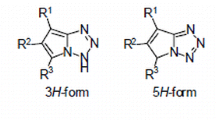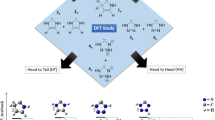Abstract
The tautomerization pathways and kinetics of 1,5-diaminotetrazole (DAT) have been investigated by means of second-order Møller-Plesset perturbation theory (MP2) and coupled-cluster theory, with single and double excitations including perturbative corrections for triple excitations (CCSD(T)). Five possible tautomers, namely 4-hydro-1-amino-5-imino-tetrazole (a), 2,5-diamino-tetrazole (b), 1,5-diamino-tetrazole (c), 2-hydro-1-imino-5-amino-tetrazole (d), and 2,4-dihydro-1,5-diimino-tetrazole (e) were identified. The structures of the reactants, transition states, and products along with the tautomerism pathways were optimized by the MP2 method using the 6-311G** basis set, and the energies were refined using CCSD(T)/6-311G**. The minimum-energy path (MEP) information for DAT was obtained at the CCSD(T)/6-311G**//MP2/6-311G** level of theory. Therein, reaction 2 (c → b) is an amino-shift reaction, while reaction 1 (c → a), reaction 3 (c → d), reaction 4 (a → e), and reaction 5 (d → e) are reactions of hydrogen-shift tautomerization. The calculated results show that 2,5-diaminotetrazole (b) with the minimum energy (taking c as a standard) among five tautomers, is the energetically preferred tautomer of DAT in the gas phase. In addition, the energy barrier of reaction 2 is 71.65 kcal · mol−1 in the gas phase, while reaction 1 takes place more easily with an activation barrier of 61.53 kcal · mol−1 also as compared to 63.71 kcal · mol−1 in reaction 3. Moreover, the tautomerization of reaction 4 requires the largest energy barrier of 83.29 kcal · mol−1, which is obviously bigger than reaction 5 with a value of 73.78 kcal · mol−1. Thus, the hydrogen-shift of c to a is the easiest transformation, while the tautomerization of a to e is the hardest one. Again, the rate constants of tautomerization have been obtained by TST, TST/Eckart, CVT, CVT/SCT, and CVT/ZCT methods in the range 200-2500 K, and analysis indicated that variational effects are small over the whole temperature range, while tunneling effects are significant in the lower temperature range.

Figure 3 shows the tautomers and reactions of the tautomerism of 1,5-diaminotetrazole (DAT) using the MP2/6-311G**. And the adiabatic ground-state potential energy curves (V G a ) and the classical potential barriers (V MEP) of the reactions also have been performed in detail. Results show that the tautomers coexisting with c, tautomers a and d are expected to be most easily derived from c experimentally. While b is the most stable, but is difficult to interchange with c. Again e is the least stable, and the V G a of the transformation from c to e is the largest, so the probability of this reaction occurring is low. All of the V MEP(s) and V G a (s) curves are similar in shape, with their maxima located at the same position (s=0), which implies that the variational effect in calculating the rate constants of the reactions will be small. Schematic representation of tautomers and reactions of DAT using the MP2/6-311G** level of theory





Similar content being viewed by others
References
Lesnikovich A, Sviridov V, Printsev G et al (1986) A new type of self-organization in combustion. Nature 323:706–707
Gaponik PN, Voitekhovich SV, Lyakhov AS et al (2005) Crystal structure and physical properties of the new 2D polymeric compound bis (1, 5-diaminotetrazole) dichlorocopper (II). Inorg Chim Acta 8:2549–2557
Bekhit AA, El-Sayed OA, Al-Allaf AKT et al (2004) Synthesis, characterization and cytotoxicity evaluation of some new platinum(II) complexes of tetrazolo[1,5-a]quinolines. Eur J Med Chem 6:499–505
Herr RJ (2002) 5-Substituted-1H-tetrazoles as carboxylic acid isosteres: medicinal chemistry and synthetic methods. Bioorg Med Chem 11:3379–3393
Pais GCG, Zhang X, Marchand C et al (2002) Structure activity of 3-aryl-1,3-diketo-containing compounds as HIV-1 integrase inhibitors1. J Med Chem 15:3184–3194
Piekiel N, Zachariah MR (2012) Decomposition of aminotetrazole based energetic materials under high heating rate conditions. J Phys Chem A 6:1519–1526
Tao G-H, Guo Y, Parrish DA et al (2010) Energetic 1,5-diamino-4H-tetrazolium nitro-substituted azolates. J Mater Chem 15:2999–3005
Tao G-H, Guo Y, Joo Y-H et al (2008) Energetic nitrogen-rich salts and ionic liquids: 5-aminotetrazole (AT) as a weak acid. J Mater Chem 45:5524–5530
Zhang Q, Zhang J, Parrish DA et al (2013) Energetic N-trinitroethyl-substituted mono-, di-, and triaminotetrazoles. Chem Eur J 33:11000–11006
Zhang Q, Shreeve JNM (2013) Growing catenated nitrogen atom chains. Angew Chem Int Ed 34:8792–8794
Tang Y, Yang H, Cheng G (2013) Recent advanced strategies for extending the nitrogen chain in the synthesis of high nitrogen compounds. Synlett 17:2183–2187
Fischer D, Klapoetke TM, Piercey DG et al (2013) Synthesis of 5-aminotetrazole-1 N-oxide and its azo derivative: a key step in the development of new energetic materials. Chem Eur J 14:4602–4613
Hollo B, Jaso V, Leovac VM et al (2013) Synthesis, structure and thermokinetic studies on perchlorate salts of metal complexes containing a formamidine-type ligand. J Coord Chem 3:453–463
Stassen AF, Kooijman H, Spek AL et al (2002) Strongly isolated ferromagnetic layers in poly-trans-μ-dichloro- and poly-trans-μ-dibromobis(1-(2-chloroethyl)-tetrazole-N4)copper(II) complexes. Inorg Chem 24:6468–6473
Stassen AF, Driessen WL, Haasnoot JG et al (2003) Structure and magnetic properties of the weak ferromagnet bis(1-(2-chloroethyl)-tetrazole)bis(nitrato)copper(II). Inorg Chim Acta 57:61
Stassen AF, Roubeau O, Ferrero Gramage I et al (2001) Physical properties of the spin-crossover compound hexakis(1-methyltetrazole-N4)iron(II) triflate, steady state and relaxation studies, X-ray structure of the isomorphic Ni(II) compound. Polyhedron 11–14:1699–1707
Roubeau O, Stassen AF, Gramage IF et al (2001) Surprising features in old and new [Fe(alkyl-tetrazole)6] spin-crossover systems. Polyhedron 11–14:1709–1716
Cui Y, Zhang J, Zhang T et al (2008) Synthesis, structural investigation, thermal decomposition mechanism and sensitivity properties of an energetic compound Cd(DAT)(6) (ClO(4))(2) (DAT = 1,5-diaminotetrazole). J Hazard Mater 1:45–50
Joo YH, Twamley B, Shreeve JM (2009) Carbonyl and oxalyl bridged bis(1,5-diaminotetrazole)-based energetic salts. Chem Eur J 36:9097–9104
Joo Y-H, Twamley B, Garg S et al (2008) Energetic nitrogen-rich derivatives of 1,5-diaminotetrazole. Angew Chem Int Ed 33:6236–6239
Klapoetke TM, Martin FA, Stierstorfer J (2012) N-bound primary nitramines based on 1,5-diaminotetrazole. Chem Eur J 5:1487–1501
Shang J, Zhang J, Cui Y et al (2010) Synthesis, crystal structure, and properties of an energetic compound Zn(1,5-diaminotetrazole)(6) (ClO4)(2). Acta Chim Sinica 3:233–238
Sinditskii VP, Egorshev VY, Dutova TY et al (2011) Combustion of derivatives of 1,5-diaminotetrazole. Explo Shock Waves 1:36–44
Wu B-D, Li F-G, Zhang T-L et al (2013) Preparation, crystal structure, and thermal decomposition of the four-coordinated zinc compound based on 1,5-diaminotetrazole. Z Anorg Und Allg Chem 7:1248–1253
Gao H, Shreeve JNM (2011) Azole-based energetic salts. Chem Rev 11:7377–7436
Jimenez V, Alderete JB (2006) Complete basis set calculations on the tautomerism and protonation of triazoles and tetrazole. J Mol Struct 775:1–7
Chen ZX, Xiao JM, Chin YN (1999) Studies on heats of formation for tetrazole derivatives with density functional theory. J Phys Chem A 103:8062–8066
Levchik SV, Ivashkevich OA, Balabanovich AI et al (1992) Thermal decomposition of 5-aminotetrazoles. Thermochim Acta 207:115
Levchik SV, Balabanovich AI, Ivashkevich OA et al (1993) The thermal decomposition of aminotetrazoles. Part 2. 1-Methyl-5-aminotetrzole and 1,5-diaminotetrazole. Thermochim Acta 225:53–65
Frisch MJ, Trucks GW, Schlegel HB, et al (2003) Gaussian 03, revision A1. Gaussian Inc, Pittsburgh, PA
Gonzalez C, Schlegel HB (1989) IRC. J Chem Phys 90:2154
Truhlar DG, Isaacson AD, Garrett BC (1985) Theory of Chemical reaction dynamics, vol. 4 [M]. CRC, Boca Raton
Truong NT, Truhlar DG (1990) TST/Eckart. J Chem Phys 93:1761
Miller WH (1979) CVT. J Am Chem Soc 101:6810
Truhlar DG, Garrett BC (1984) CVT. Annu Rev Phys Chem 35:159
Truong NT (1994) CVT. J Chem Phys 100:8014
Liu YP, Lynch GC, Troung TN et al (1993) CVT/SCT. J Am Chem Soc 115:2408
Truhlar DG, Isaacson AD, Garrett BC (1982) CVT/SCT. J Phys Chem 85:2252
Garrett BC, Truhlar DG, Grev RS et al (1980) ZCT. J Phys Chem 84:1730
Truhlar DG, Isaacson AD, Skodje RT et al (1982) ZCT. J Phys Chem 86:2252
Zhang SW, Truong TN (2001) VKLab version 1.0 [M]. University of Utah
Chuang YY, Corchado JC, Fast PL, et al (1999) POLYRATE, Program vision 8.2 [M]. Minneapolis
Zhang L P, Tu Y R (1980) Foundation of organic chemistry (theory and application) (trans) [M]. Higher Education Press, Beijing
Harmony MD, Laurie VW, Kuczkowski RL et al (1979) Molecular structures of gas-phase polyatomic molecules determined by spectroscopic methods. J Phys Chern Ref Data 3:619–722
Acknowledgments
The authors would like to thank Professor D. G. Truhlar for providing the POLYRATE 8.2 program. The project was supported by the NSAF Foundation (No. 10776002) of National Natural Science Foundation of China and Chinese Academy of Engineering Physics.
Author information
Authors and Affiliations
Corresponding author
Rights and permissions
About this article
Cite this article
He, P., Zhang, JG., Feng, LN. et al. Theoretical study on the tautomerization of 1,5-diaminotetrazole (DAT). J Mol Model 20, 2457 (2014). https://doi.org/10.1007/s00894-014-2457-4
Received:
Accepted:
Published:
DOI: https://doi.org/10.1007/s00894-014-2457-4




